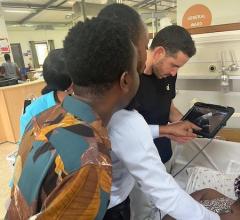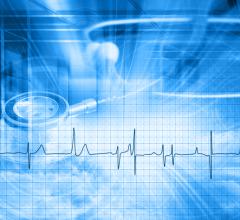
Telecradiology remote monitroing programs grew rapidly during the COVID-19 pandemic. An example of a remote cardiac monitor that saw increased use is InfoBionic's MoMe Kardia device. It offers mobile cardiac telemetry with near real-time, on-demand full disclosure of ECG data 24/7. Using a wearable monitor, MoMe continuously records telemetry data, uploading it to a cloud-based platform that clinicians may access at anytime.
June 22, 2021 — It is no secret that the use of telehealth technologies rose dramatically with the onset of the COVID-19 pandemic. In efforts to keep patients safe, doctors across the country turned to remote patient monitoring (RPM) to evaluate and monitor patients while keeping them at home. Even before the pandemic, nine out of 10 healthcare providers indicated they were evaluating or had already invested in remote patient monitoring technologies to better assist their patients.[1] And now, as America seems to be rounding out of the pandemic, telehealth and RPM are here to stay—so believes the American Medical Association.[2]
“COVID-19 strained our already overburdened healthcare system to the max, and many doctors chose to go with remote patient monitoring to help alleviate that strain and keep patients safe from COVID-19. But not all RPM devices are created equal, and doctors need to feel confident that their choice of technology provides a truly comprehensive picture of a patient’s health,” explains Stuart Long, CEO of InfoBionic, a digital health company that offers wearable cardiac monitoring technology.
Remote patient monitoring uses innovative technological tools to gather and track patient data outside standard healthcare settings.[3] Cardiology was one of the first medical specialties to incorporate RPM into standard practice.[4] Some studies already show that patients using RPM showed a 50% drop in mortality from arrhythmias and congestive heart failure compared to those receiving standard, in-person follow-up.[4]
How does Remote Cardiac Monitoring Technology Work?
By remotely transitioning the monitor between Holter, event and MCT during monitoring periods (depending on patient need), RPM streamlines office and hospital visits.[5] It also can eliminate the need for intermediaries in patient enrollments, IDTF data delays and helps to gain control of patient compliance.[5]
Several remote monitors today record every single heartbeat and provide on-demand access to 100% of acquired heartbeats. The data can enhance the clinician's ability to detect—and make timely diagnoses of atrial fibrillation, tachycardia and other arrhythmias. The physician can facilitate decision-making with control of all reporting and get all the data needed to optimize diagnosis accuracy.[5]
Remote cardiac monitoring has become part of the standard of care for cardiac patients, especially those with implantable cardiac devices.[6] Easy access to real-time telemetry data allows cardiologists to decide whether symptoms represent true medical emergencies, essentially creating a “hospital without walls”. Additionally, one-fourth of healthcare organizations report that RPM reduces emergency department visits and hospital readmissions; 38% of organizations say the technology results in fewer inpatient admissions for problems like heart disease or chronic obstructive pulmonary disease.[7]
An example of this is the InfoBionic MoMe Kardia device that offers mobile cardiac telemetry (MCT) with near real-time, on-demand full disclosure of ECG data 24/7. Using a one-piece monitor, MoMe continuously records telemetry data, uploading it to a cloud-based platform that clinicians may access anytime, anywhere. Automated reports show onset, offset and other supplementary data that any cardiologist may use to verify or rule out cardiac events. The device presents this information in a HIPAA-compliant portal that helps to protect sensitive patient health information.
The Future of Remote Patient Monitoring
Current generations of remote patient monitoring technology cannot monitor all vitals — oxygen level, ECG, blood pressure, blood glucose and other clinical parameters at the same time and/or in the same device. However, biotech companies are working to develop a kind of "tricorder" technology, similar to that seen in Star Trek. Long anticipates that this kind of innovative technology will become more precise, more accepted and simple to use in the not too distant future.
In fact, in 2012, a contest was announced to develop a medical tricorder and win a $10 million prize. Three hundred teams competed and in 2017, two biotech companies were chosen to lead the project.[8] According to a Scientific American article, “The main aim of the two prizewinners is to integrate several technologies in one device. They have not created an all-in-one handheld machine, but they do both represent significant steps forward.”[9]
While the standard office visit is not yet a thing of the past, many believe that RPM technologies represent the future of healthcare. Doctors, explains Long, will probably use a hybrid model, combining in-person care with virtual visits for a more comprehensive and convenient approach to care. RPM technology will be key to differentiating true emergencies from non-emergent situations, which benefits both the patient and the healthcare system as a whole.
“As our technology advances, we hope that more providers will come to realize just how important full disclosure data is to making an accurate diagnosis and improving patient outcomes," Long explained. "We’re already seeing the widespread adoption of these technologies, and we believe their use in healthcare will continue to expand.”
References:


 November 12, 2025
November 12, 2025 









